30's Hitch: Number Seventeen (1932)
"You don't have to do nothin' in this here house; you stay still and things happen." - Ben, in Number Seventeen
Another adaptation from a stage play, another dismissed work, Number Seventeen is a challenging little (literally; it's only a few minutes over an hour long) film. As Charles Barr points out, Hitchcock himself deployed a little disingenuous revisionism about the genesis of the work. I'll get to that momentarily but for now, I'm struck by the film for a constellation of completely different reasons.
Out of the gate, if I approach the film as a narrative, it's borderline incomprehensible and as a work of Hitchcock's, it comes across as perversely sloppy and even idiotic. However, as an experimental work seen as something less linear, it becomes far richer.
The plot, such as it is, involves a necklace, a detective, jewel thieves, all of whom come together in an "old, dark house". I'm not being (well, completely) coy in that choice of words. There is, apparently, a sense among some critics that there was some overlap between James Whale's film and Hitchcock's, but it's too much of a stretch. Aside from both being set in such an edifice with ensembles, and both being seriocomic, there's not much else the two films share. As a more straightforward (and entertaining) narrative, Whale's is superior. But where I find Hitchcock's more fascinating are in aspects of the film that render it unwieldy as just that.
It's only straightforward in the broad landscape of the tale. There's the necklace, the ring of thieves; there's a moment of violence, the thieves escaping, and intrepid heroes in pursuit. There's even something like a romantic conclusion that also makes no sense because the relationship between the two parties comes out of nowhere (except insofar as the woman - one of the jewel thieves - comes to the aid of the detective).
There's also Ben, a drunkard and rascally fellow, played by Leon M. Lion, who like so many others of the players in British cinema at the time, had an extensive career in the theater as an actor and playwright. Lion's performance is the only one that evinces any kind of life and that's not necessarily saying it's good. It's pretty hammy and almost annoying until you realize how dead and dreadfully dull everyone else's work is.
The film opens with a hat blowing down the street to the gate before the old manse. The Coen brothers nicked the motif for Miller's Crossing where I would argue the brothers put the image to much better use as a thematic touchstone for the rest of their movie. Here? I don't know that I want to read too much into it, unless it really is intended to carry more weight symbolically than it warrants in a film so odd.
Once inside, the hat's owner looks around and casts his eyes upward where he spies a body. Ben enters the scene and we have to deal with little detection, nothing of any moment; Ben is a frightened dipsomaniac and our stolid fellow does nothing that evinces much curiosity regarding the body. He doesn't check the body for clues, doesn't really verify the "corpse's" status (spoiler: despite our guy declaring the body an ex-living human, it/he's not...oh, and spoiler number two: we find out later that our guy is the detective. Sit with that for a minute.) It's Ben who finds a gun on the reposed man, and handcuffs. Our detective guy does find a card with "Number Seventeen" on it, the number of the address of the house.
In short order, a woman appears, the man turns out to be her father, who is a policeman following the thieves and who feigned unconsciousness to lure them into a false sense of security and/or because he knew Detective Barton was on the case. Again, this isn't made terribly clear; but that's not necessarily a problem, as I'll get to momentarily.
By now, we've made the acquaintance of the band of three thieves; Brant, who seems to be one of the leaders, Nora - a deaf-mute, and Henry Doyle. The reveal the telegram that alerts us that a man named Sheldrake will come to retrieve the necklace. It is Sheldrake whom the police officer (Ackroyd, if we want to keep track) impersonates, and it is Sheldrake who does show up, finds the necklace hidden in the toilet tank and who winds up locked in the loo when Ben creates a diversion.
To be clear, Sheldrake enters from another part of the house; he hasn't met his gang yet and it's not clear that they know what he looks like since Ackroyd impersonates him. Brant suggests they tie up Ackroyd's daughter and Barton, but Ackroyd locks up the three thieves (the Gang of Three?) and frees his daughter and Barton. He also makes a tactical error when he opens a door to find Sheldrake who overpowers him, frees his cohort, and has them bind our heroes again. Ben is out of commission, having been beaten by Sheldrake, but who also pinched the necklace from Sheldrake.
All of this happens in a weirdly paced half-hour, concluding with Nora coming back and freeing them (and yes, she's not a deaf-mute) and then fleeing with the gang on a train bound for Germany.
The second half of the film is comprised of Barton and Ben in somewhat hot pursuit. Ben has made it onto the train, discovers a freight car filled with crates of wine. Three guesses what he does. Barton, in a remarkably ballsy move, commandeers a bus to chase the train! Yes, this is nuts. However, it's also here where Hitchcock is finally able to cut loose and use cross-cutting and multiple edits to actually generate a sense of excitement, if not suspense or tension. It also gives him a chance to work with miniatures, giving us an idea of what's to come in a year or two in much better films.
There's some amusement in the reveal that Sheldrake doesn't have the necklace, that Ben is smashed on wine, and the gang begins to turn on each other, all the while the train is hurtling along to disaster since the idiots killed the engineer. Doyle escapes Brant and Sheldrake, handcuffs Nora but the train jumps the tracks and speeds across the water, partly onto the waiting ferry. Barton watches as train cars plummet into the bay and jumps into the water. People are rescued and Doyle tells Barton he can't arrest him; Doyle claims he's Barton and there is some wit, I guess, when Barton sets him right. Barton detains Nora as the rest of the gang is escorted away. He intimates that they'll have a bite and we assume that's she's just been given the old second chance. The film ends on Ben revealing the necklace on his necklace.
Now, all this may sound way too formulaic and turgid for an Alfred Hitchcock film, and it is. However, why I think there's more to it is precisely because of how minimal it is; these are barely sketched characters, a threadbare plot, but a neatly divided in two structure where the first half is quasi-oneiric and the second is almost from a different film. Because the characters are so inconsequential and hardly read as individuals with any type of interiority, the film itself feels more like an experiment in blocking and camera angles. And that's where it grabbed my interest; in the abstract, as an abstract film, Number Seventeen actually works but for the pacing. As tedious as the first half is, I wanted to slow it down, introduce more pauses and completely do away with dialog. There's a formalism to that first half that gives us the sense that if Hitchcock wasn't invested or interested in the piece, he was going to amuse himself anyway.
With the second half, I might actually dispense with it completely and let the first half end the film on the enigmatic note of Nora freeing everyone and vanishing as the screen fades to black or if we have to have the second half, speed it up and slow it back down toward the final sequence of Nora, Barton, and Ben. stretching out Ben's reveal as though he were attempting drag.
Visually, the film is somewhat fascinating; the camera does, arguably, more character work than the actors. In some ways, it harkens back to the German Expressionist cinema with its angles, overheads, the use of shadows that aren't really connected to the objects that cast them. Early on, we see a full hand cast upon a wall, more totemic than like an actual hand; this, and other shots of shadows against the walls calls to mind Murnau's Nosferatu.
The fight seen in the bathroom between Sheldrake and Ben is a close quarters affair that comes across as fairly brutal. The sound design during the fight are grunts of two men obviously not in synch with what's going on and muffled blows. The orientation is almost wholly vertical in a cramped space that echoes the earlier journey up the stairs by Barton and another vertically oriented shot of Barton and Ackroyd's daughter suspended handcuffed to a collapsed banister.
The interior of the house would be, in other films, as much a psychological as physical space, but there characters just don't carry the depth to support any such interpretation, and yet, as Strauss points out in Hitchcock's Objects as Subjects, the house is the main character of the first part of the film(1).
When we enter the more propulsive second part, the imbroglio on the train and the bus chasing after, as I mentioned earlier, the editing and the use of sound, bring us into something like genuine suspense. Unfortunately, there is this distance that keeps us from getting too involved because of the thinness of the figures in our play. Even so, Hitchcock has provided a formal exercise that any film student would do well to learn from and perhaps, we have enough examples today, of well-staged action being a thing-in-itself. If set up expertly enough, we are still going to respond to what unfolds on screen.
Ben's line that opened this post rather sums up the structure, if not the entirety of the movie. In some ways, it's almost a Hitchcockian mission statement: in life - or at least, in his films, you don't have to do anything, things will happen.
There are other elements that are not out of place in the master's ouevre, but if we're to believe him, this was a movie forced on him by the producers after an under-performing Rich and Strange. Charles Barr debunks this somewhat(2) and while that's an issue I'll take up another time, it's worth bearing in mind that there are times when Hitchcock has disparaged his work that it seems couched in convenient memory or shaping his myth, history, and legacy in discussions later in his career. Naturally, he's not alone in this, but it does make for challenges when we want to look at and discuss authorial intent, let alone various strata and strategies of interpretation, and sometimes, just get some kind of clue as to why this film is this way.
As much as Hitchcock disparaged this film(3) and as much as I can't take it too seriously as a narrative, it doesn't feel as stage-bound as Juno and the Paycock or The Skin Game. It may not have been a personal film that Hitchcock wanted to make, but it does have a sense of fun about it (J. Jefferson Farjeon's play was referred to as a 'joyous melodrama'(4)). It is goofy and not just by our present standards.(5)
I think that each of the films for BPI that lead us to the sextet of thrillers to come are, at the very least, significant as examples of a master craftsman doing his best with material that, if not quite as interesting or involving as what would come later, provided him with a sandbox to develop tools that he would use later. Even Murder!, which smacks most of what's to come has a feeling of constriction and restriction.
I hope I've made something of a case, too, that Hitchcock's films of the earlier 1930s don't necessarily merit full dismissal. Are they great films? No, probably at their best (Murder!, maybe Waltzes from Vienna, and perhaps Rich and Strange) are actually quite good. The remainder are worth looking at for how Hitchcock is applying his unique grammar to vehicles that can't really support it. The reason I've droned on about Number Seventeen as much as I have is because it really does strike me more as an experimental film than anything else.
As much as he might have eschewed discussing theory, and as much as he would emphasize that he was just trying to entertain people, there's far too much in his work to take that at face value. One of the reasons I do spend as much time as I have on these pre-The Man Who Knew Too Much films is because I think it's important to see just how mature he was by the dawn of the sound era. The idea that his early '30s work was that of a journeyman or apprentice just doesn't ring true.
There are other elements of the period that I want to address before we get to the Suspenseful Six; this will be a separate post and one that I hope addresses some lacunae throughout this series.
Gallery
Here's what I mean by an emphasis on vertical orientation:
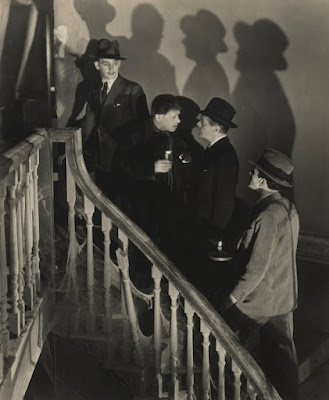 |
| The gang going up the stairs |
 |
| Ann Casson as Miss Ackroyd and John Stuart as Detective Barton hanging on |
Shadows and set-ups. The following compositions are striking and demonstrate how much of the work the cinematography is doing.
Notes
1. "This house is so much more interesting because of its emptiness than any of the actors playing their parts." Strauss, 2016.
2. Barr, p. 123.
3. In Truffaut, 1985: "A disaster!" Additionally, Hitchcock here floated the idea that the film was a parody (this was also proffered by Rohmer and Chabrol, as well) and thankfully, Barr addresses and corrects both that initial assertion and subsequent interpretation. "...the film remains closer to teh original, in substance and spirit, than Hitchcock liked people to believe - it's not surpising if nobody recognised it as a parody of the original, since it really wasn't one at all" and even more important, for our immediate purposes, "it provided new structural elements that Hitchcock would adopt and make his own." (Barr, op. cit.)
4. Barr, p. 123
5. Variety, August 2, 1932, p. 36, for example.
Bibiliography
Barr, Charles. English Hitchcock. Cameron and Hollis. Dumfriesshire, Scotland. 1999.
Truffaut, Francois with Scott, Helen G.. Hitchcock-Truffaut. Simon and Shuster Touchstone. New York. 1985.
"Film Reviews: Number Seventeen". Variety. New York. August 2, 1932.

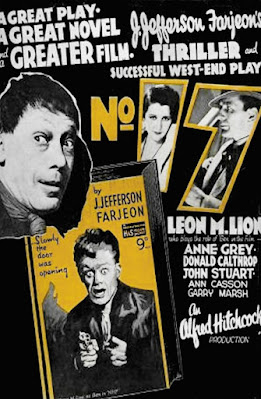


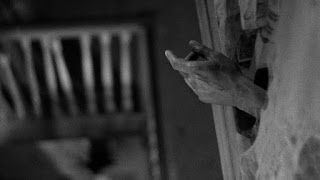
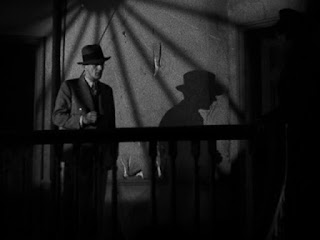
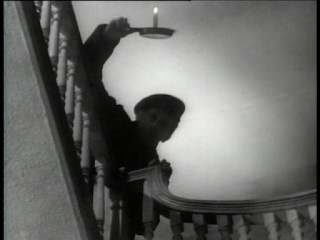



Comments
Post a Comment